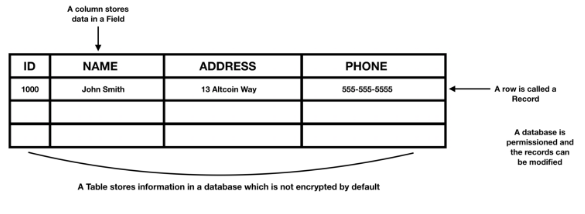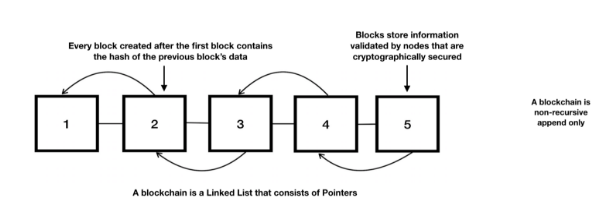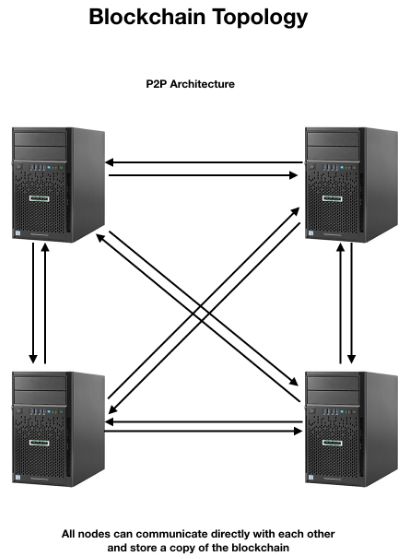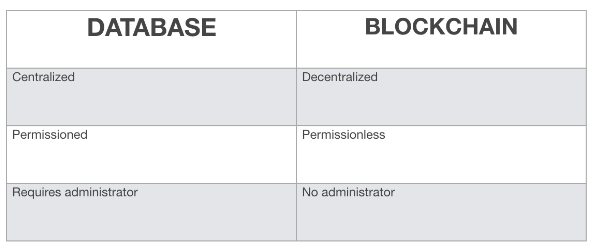What is the difference between database and blockchain?
There will always be a lot of confusion about databases and blockchains. Blockchain is actually a kind of database, because it is a digital ledger and stores information on the data structure of the block. The structure of storing information in a database is called a table. However, the blockchain is a database, and the database is not a blockchain. Although they all store information, their designs are completely different, so they are not interchangeable. Moreover, the goals of the two are also different, so for many people, they are not very clear why the blockchain is needed, and why the database is more suitable for storing certain data.
First, let's take a look at the difference between a database and a blockchain.
database
A traditional database is a data structure used to store information. This contains the data needed to produce reports that support various business, financial, and management decisions. The government also uses databases to store large amounts of data, which can have millions of records. The database starts from the file classification system and provides the most basic information acquisition and storage functions. Then, the database uses a related model, and by correlating multiple databases, data can be obtained in more complex ways. The information stored in the database can be managed using a management system. Simple databases are stored in rows and columns of data, called tables. The table contains different fields, which are used to define the types of different records. The stored data is called attributes. Each field contains columns and lines, which represent stored records.

The database can be modified, managed and controlled by the administrator. There will always be an administrator in the database and can fully control the database. They can create, delete, and modify any record in the database. They can optimize the performance and size of the database. Larger databases will have slower performance, so administrators can use methods to optimize. The administrator can also transfer this identity to others. For example, the administrator can transfer the identity to another user and let them back up the database. However, there will be problems. For example, if the server is crossed, the only way is to restore from backup. The database is also recursive, which means you can go back and repeat a task, or delete a task. If the information has been backed up, the administrator will delete the previous records and other out-of-date information. For example, you have written "JohnSmith" in the current database, and now you need to update your address. But now there is a backup of "JohnSmith", so you can update it with the new address of the existing database.

The database can be implemented through a server architecture. This is because computers need to connect to the server, and they manage the database, so that information and stored data can be obtained. Initially, the database client used ODBC to connect, which was set by the administrator, and then connected to the database. The client software will then run to complete the encrypted connection, but you must have permission to enter. This permission can be set by the administrator, or the user can enter with a password. This is why user accounts are created to allow authenticated users to enter, while rejecting those who are not authenticated. Most systems now use a web interface. But for private information, authentication is still required, but the public database can be easily accessed through the web.
We can see that the database needs sufficient control, which makes it highly centralized. At the same time, this also needs to be allowed, which means that the administrator needs to set how to let users enter. In a production environment, DB administrators need to set read-only permissions, and they also need to set update and write permissions for users. The centralization of traditional databases will ensure the security and trust of the system. Many databases will run under a private network, and behind it is the firewall of a large company. Other databases are based on cloud servers. But they still need administrators to control them.
Blockchain
For the description of blockchain, we think of Bitcoin. But there are also many private chains that operate in an enterprise environment. Blockchain was born in 2009, and Bitcoin is the first system based on it. In the Bitcoin system, the blockchain is an unalterable digital ledger, and it is also a growing encrypted distributed database. The blockchain will store information in blocks of the same size. Each block will contain the hash information of the previous block, thereby providing encryption security. The information of this hash is the data and signature in the previous block, and the hash of the previous block will return to the first block of the blockchain, which is called the "Genesis Block". The entire information will pass through the hash and point to the address of the next block. Blockchain data structures, such as Merkel trees, are very effective data verification methods.

In order for blocks to be added to the blockchain, game theory is included in the entire process. The computer as a node in the network is called a "miner" and must compete to find the correct value from the nonce. Miners must use computing resources to solve this value, and this also requires computer hardware. The built-in protocol of the blockchain can use the computing power of the entire network to determine the difficulty of solving the problem. This means that if there are more miners, the more difficult it is to solve the problem. This is because if there are more miners, there will be more computing resources on the network and at the same time increase the hash power, which is h/s. Once miners verify the block, they will be rewarded for providing computing power. This part of the incentive is the motivation to push nodes to mine, because they will receive transaction fees and tokens. In Bitcoin, this is also called a proof-of-work algorithm.
As we have seen, the blockchain uses a decentralized distributed network. Decentralization means that all nodes in the network will store a backup of the blockchain. The node stores the backup of the full node, or it is mining, or both of them can do it. There is no administrator to verify the block transfer. You need miners who can solve the encryption problem, but this is based on the percentage of the entire network's computing power. Once the block is added to the chain, this information is immutable and transparent. Blockchain transfers are irreversible, which also means that once the block is verified, they cannot be reused. The blockchain is fault-tolerant, because if one or more nodes go down, there will always be other nodes running the blockchain. Another advantage of decentralization is that it can provide transparency to those who do not know or trust. Blockchain will improve trust by recording transfers, and provide encryption and security algorithms to trade data.

Blockchain is the network architecture of P2P. It does not need a centralized database, but all nodes in the network are connected to each other. Therefore, no one can control all nodes. No administrator is required on the blockchain. What if someone in the node is cheating? Will this affect the entire network? The theoretical answer is that if they get most of the computing power, then it is possible. In theory, if someone can control 51% of the computing power, they can control the network. This requires a lot of computing resources, so it is very expensive to generate an attack. It is profitable to use computing resources to mine. The essence of ensuring the security of the blockchain is decentralization. If someone wants to modify any information on the blockchain, they need the help of others to verify it. This will split a new chain from the main chain, and it will only be effective if it is longer than the main chain. Similar to Bitcoin, there are thousands of nodes, so if fraud is required, all nodes in the network need to be changed. In fact, this requires a lot of calculation and power, and it is also very difficult to complete. This is a way of supervision, in order to ensure that no one can deceive anyone. This is why the blockchain is unchangeable. At the same time, since the transfer information can be seen by anyone, it is also transparent.
This is the difference between blockchain and database in the underlying architecture.

Blockchain and database, when should you use which one?
The database is more suitable for enterprise networks due to its good stability. They are also more friendly to users, and there are many supporting management systems for administrators and developers. Forbes' top 500 companies all use databases to run high-end systems to process large amounts of data. The database can be expanded to millions of records, and it can handle thousands of transfers per second. For handling large amounts of traffic, such as retail, a database is the best solution. Blockchain does not need to store a lot of processing for analysis, the database can store more data, and because it does not require nodes, the processing speed is also faster. You also don't need to encrypt every data. Usually, the database is not encrypted, because encryption will add a lot of redundancy to the database. Traditional databases will increase encryption through authorization.
Unstructured data is another place where blockchain is not needed. These are more suitable for database management systems. The data does not require trust verification, just like the daily data of the store will be recorded in the database. If the blockchain is used to store private information, the cost will be high. Information that only certain companies know, such as social security and medical records, are stored in the database. The information that can be used through the public verification system can be based on the blockchain. These personal information can be authenticated on the blockchain based on a public key encryption algorithm.
The database is suitable for:
Data that needs to be constantly updated, such as monitoring and sensors
Fast online transfer process
Private information (not open to the public)
Financial data that needs to be processed quickly
Data that does not require verification
Application for storing data
Relational data
The need of blockchain is to build trust and transparency. Simply put, it is a public ledger that allows anyone to obtain information. It can help B2B transfers, such as supply chain, product distribution and inventory to verify information. Transparency can help companies such as the advertising industry to minimize fraud by establishing more verification of advertising companies. Blockchain does not mean that large data records will have more information verification. Bitcoin is the first successful deployment of the blockchain, and it is also used as a system for value transfer and payment transfer verification. The success of Bitcoin also raises the problem of double spending, which allows users to spend twice on the same token. Bitcoin uses a time stamp sequence to verify transfers. This will allow the system to process the transfer at the same time to prevent double spending, which will be done in chronological order.
Some projects are studying the permission system of the blockchain and applying them to the voting system. Since the blockchain can verify the identity and who will vote, it actually makes a lot of sense. The main goal is to prevent fraud, so blockchain can guarantee the fairness of trust. Some blockchains do not require digital currency or mining, such as enterprise-level blockchains. In a private and licensable environment, the use of blockchain technology can have a new level of system, and sometimes it will also be integrated with the database to complete a hybrid system.
The database administrator will find that the blockchain is irrelevant. You cannot create links between different blockchains and related data. This is the major difference between the two, so when the information needs relevance, blockchain is not suitable for these.
Other blockchain applications, such as smart contracts on Ethereum. These are more like database storage processes, where triggers can be used to execute code to process transfers. In the Ethereum network, smart contracts will run code on all nodes in the network. Ethereum and other digital currencies such as EOS and NEO will use blockchain as their smart contract ecosystem. This is a case of distinguishing between blockchain and traditional databases.
Blockchain is suitable for:
Fund transfer
Value transfer
Verification of trusted data (identity, reputation, credit, etc.)
Public key verification
Decentralized APP
Voting system
There is much to discuss about blockchain and databases. We only discovered some of these situations from a technical point of view. In fact, no database and blockchain are better than others. They all have their own goals and choose different solutions based on how you want to process the data.
Do you know which is the most competitive student laptop for elementary students or daily entertainment? It`s this 14.1 inch celeron n4020 64gb laptops on sale for students, since not only lightweight, but also entry celeron cpu, storage, longer lasting battery, etc. More than 80% clients choose this student chromebooks for students tender cause it`s of all features of laptop for online classes. Of course, this model is also suitable for operating student laptop deals.
As a professional oem&ODM manufacture, never let you down. No matter you look for 14inch 64gb student pc, 15.6 inch N5095 Teacher Laptop, 15.6 inch 10th or 11th University Laptop, 16.1 inch 4gb graphics recommended laptop for programming, Android Tablet, Mini PC or All In One PC , always have the right one here for you.
Therefore, just feel free to contact us and share your basic requirement, like size, cpu, ram, rm, quantity, special requirements, so that send back right details for you.
Of course, any other things except business we can do in China, also willing help.
Student Laptop,Student Laptop Deals,Laptops On Sale For Students,Student Pc,Laptop For Online Classes
Henan Shuyi Electronics Co., Ltd. , https://www.shuyiminipc.com